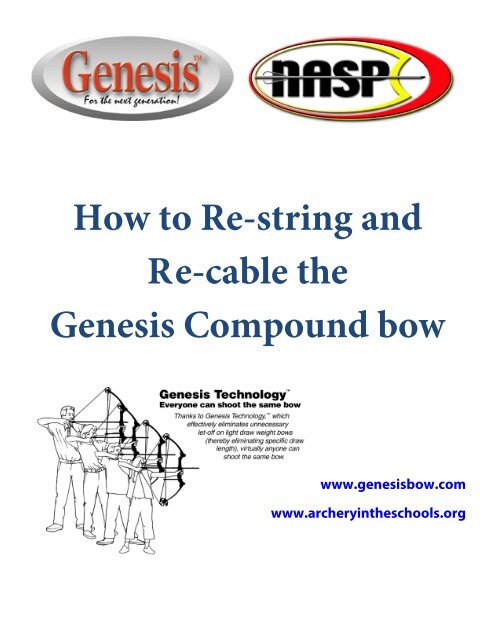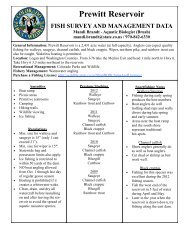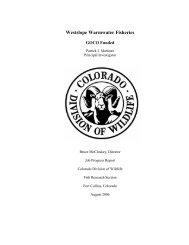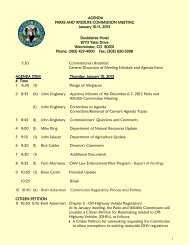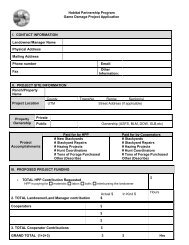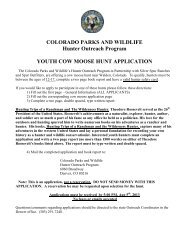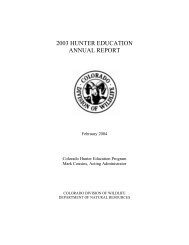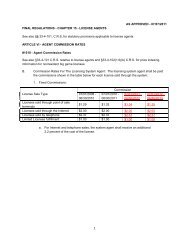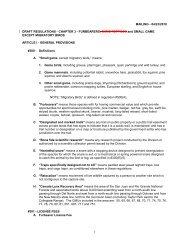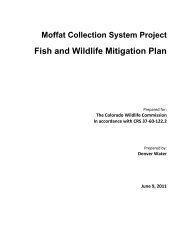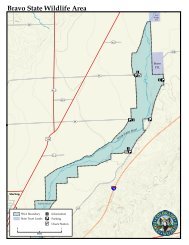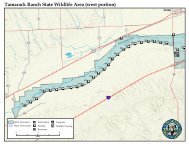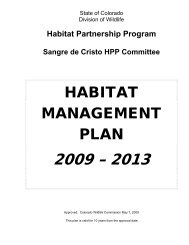How-to Restring and Recable Genesis Bows
How-to Restring and Recable Genesis Bows
How-to Restring and Recable Genesis Bows
Create successful ePaper yourself
Turn your PDF publications into a flip-book with our unique Google optimized e-Paper software.
<strong>How</strong> <strong>to</strong> Re-string <strong>and</strong><br />
R e-cable the<br />
<strong>Genesis</strong> Compound bow<br />
www.genesisbow.com<br />
www.archeryintheschools.org
Introduction <strong>and</strong> Terminology<br />
Inspect all bows prior <strong>to</strong> use. Once a string or cable has become worn, it is very important that it be<br />
replaced prior <strong>to</strong> using the bow anymore. Using any bow with a damaged string or cable can result in<br />
damage <strong>to</strong> the bow, the user or by-st<strong>and</strong>ers. Use these detailed simple steps <strong>to</strong> replace the string <strong>and</strong> cable<br />
on your <strong>Genesis</strong> Compound bow.<br />
The part of the bow above the grip is<br />
known as the sight window.<br />
This bow would be considered <strong>and</strong><br />
referred <strong>to</strong> as sight window out.<br />
This bow would be considered<br />
<strong>and</strong> referred <strong>to</strong> as sight window down.<br />
This is the Idler wheel.<br />
(<strong>to</strong>p of the bow, when in shooting position)<br />
This is the <strong>Genesis</strong> Cam.<br />
(bot<strong>to</strong>m of the bow, when in shooting position)
- 3/16 Allen wrench<br />
- Flat table, clean working surface<br />
- Scissors<br />
- Lighter<br />
- Bow square (pictured <strong>to</strong> the right)<br />
Tools Required<br />
Materials Required<br />
- New String<br />
- New Cable<br />
- Fast flight material (for tying new nock point in place)<br />
**Hint: cut a str<strong>and</strong> from the old bowstring <strong>to</strong> save money.**<br />
Maintaining the Bow<br />
All instructions in the following pages are for “RIGHT HANDED” bows.<br />
Adjusting the Draw Weight of the Bow<br />
Locate the limb bolts on either end of the limb cups. If the limb bolts are<br />
not tightened down (peak weight) do so at this time.<br />
This is what a bow looks like set at<br />
the peak draw weight.<br />
(20 lbs for st<strong>and</strong>ard <strong>Genesis</strong> NASP bow)<br />
There is no space in the limb pocket. If there is space<br />
in the limb pocket, insert the 3/16 Allen wrench <strong>and</strong><br />
tighten (see note below about keeping bow in balance!)
Using a marker of some sort, mark the limb bolts with a line so that<br />
you can easily count the rotations<br />
Top bolt<br />
Install 3/16 wrench in head of bolt <strong>and</strong> turn counter<br />
clockwise as follows. One turn out on <strong>to</strong>p one turn out at<br />
the bot<strong>to</strong>m. Until you have backed limbs out approximately 10<br />
turns each.<br />
Bot<strong>to</strong>m bolt<br />
REMEMBER TO ADJUST BOWS IN BALANCE!<br />
Back weight - adjust bolts out or tighten as follows:<br />
-1 turn <strong>to</strong>p, 1 turn bot<strong>to</strong>m<br />
-1 turn <strong>to</strong>p, 1 turn bot<strong>to</strong>m<br />
-1 turn <strong>to</strong>p, 1 turn bot<strong>to</strong>m<br />
-1 turn <strong>to</strong>p, 1 turn bot<strong>to</strong>m<br />
-1 turn <strong>to</strong>p, 1 turn bot<strong>to</strong>m<br />
So on <strong>and</strong> so forth until you completed 10 rotations on both <strong>to</strong>p <strong>and</strong> bot<strong>to</strong>m.<br />
Never back 10 turns off the <strong>to</strong>p <strong>and</strong> then follow with 10 turns off the bot<strong>to</strong>m. If you lose count<br />
on the side you start with, the bow can be damaged <strong>and</strong> or injury may result <strong>to</strong> you or persons<br />
that are close by.
Replacing the cable <strong>and</strong> string<br />
1. Remove cable guard slide<br />
BEFORE<br />
Once the limbs have been backed off 10 turns on<br />
both sides, carefully remove the cable guard slide<br />
as shown. Set aside in a safe place for reinstallation.<br />
If you lose the cable slide, the<br />
bow will not function properly without it. Do<br />
not attempt <strong>to</strong> shoot the bow without a cable<br />
slide as arrow will not stay on the arrow rest<br />
<strong>and</strong> may result in damage <strong>to</strong> the bow <strong>and</strong> or<br />
injury.<br />
AFTER<br />
2. Lay bow on flat surface<br />
Start with the bow sight window down<br />
3. Remove old string <strong>and</strong> cable<br />
A. Locate cable<br />
B. Remove cable from cable post
C. Locate idler wheel cable connections<br />
D. Remove cable loops from BOTH sides of Idler wheel<br />
E. Set old cable aside (hint, str<strong>and</strong>s can be cut from the<br />
old cable <strong>to</strong> later tie a nock loca<strong>to</strong>r on new string)<br />
F. With the bow still in the sight window down<br />
position, remove the two colored string from the cam<br />
post that is accessible in this position
G. Next, holding both limbs in place, flip the bow over.<br />
Now that the bow is in the sight window UP position, you<br />
can easily remove the other string loop.<br />
H. Set both old string <strong>and</strong> cable aside for later use as<br />
nock loca<strong>to</strong>r material, unless you have a spool of new fast<br />
flight material readily available.<br />
4. Install the new string <strong>and</strong> cable<br />
A. Identify string - longer <strong>and</strong> two colored also<br />
only has one loop at each end.<br />
B. Identify cable - shorter <strong>and</strong> solid<br />
black, one side has a split yoke <strong>to</strong> attach<br />
<strong>to</strong> each side of idler wheel axle spools.
C. The bow was last in the sight window up position. Carefully turn the bow over in<strong>to</strong> the<br />
sight window down position <strong>to</strong> prepare for new string <strong>and</strong> cable installation.<br />
D. Carefully inspect limbs <strong>and</strong> limb pockets at this time <strong>to</strong> ensure that they are still<br />
carefully seated in<strong>to</strong> the proper locations.<br />
**Hint -Keep a completely strung <strong>Genesis</strong> bow nearby for reference should you need it.**<br />
Idler side<br />
E. Identify the new cable (shorter one,<br />
all black with two loops on one end <strong>and</strong><br />
a single loop on the other end) Lay<br />
cable out on flat working surface as<br />
shown for ease of installation.<br />
Cam side<br />
F. Start with the split yoke (two loop side) of the cable,<br />
install the loops over the black spools that attach <strong>to</strong><br />
the upper axle. Carefully lift up on the idler wheel side<br />
<strong>and</strong> attach on the opposite side of axle spool.
G. Install single loop side of<br />
cable on<strong>to</strong> cam post<br />
H. Identify the different<br />
sides of the string <strong>to</strong> insure<br />
the correct side is installed<br />
on the correct cam post.<br />
1. Identify the center serving<br />
portion of the bow string.<br />
The center serving on a fac<strong>to</strong>ry<br />
original <strong>Genesis</strong> string will measure<br />
4 ¾” <strong>and</strong> be served with black <strong>and</strong><br />
white material.<br />
2. Identify the longest twisted portion of<br />
the string that does not have any serving on<br />
it. With the <strong>Genesis</strong> bow still in the sight<br />
window down position on your flat surface,<br />
follow the twisted portion <strong>to</strong> the right <strong>to</strong><br />
find the end loop you will start with.<br />
Sight window down
Step 1<br />
I. Now that you have identified the loop<br />
that needs <strong>to</strong> be installed, the chosen end<br />
will NOT go through the limbs as the<br />
previous cable did, install this loop <strong>to</strong> the<br />
outside.<br />
Step 2<br />
Step 3<br />
Remember, DO NOT insert string<br />
loop through the limbs, follow <strong>to</strong> the<br />
outside <strong>and</strong> back around the<br />
curvature of the appropriate string<br />
track on the cam as shown in Step 3<br />
J. After installing loop on cam<br />
peg, carefully wrap string around<br />
the track groove heading back<br />
<strong>to</strong>wards the idler wheel. Make<br />
sure the string crosses over the<br />
cable (shorter, solid black) as you<br />
are headed back <strong>to</strong>wards the idler<br />
wheel side of the bow.<br />
The string crosses over the cable
H. Thread string through the idler wheel.<br />
Step 2<br />
Step 1<br />
Step 3<br />
I. Take string from idler wheel back <strong>to</strong> the cam.<br />
1<br />
2<br />
3 4<br />
J. Insert string<br />
through limbs from<br />
the back side, string<br />
should pass under<br />
the string <strong>and</strong> cable<br />
that is already<br />
installed.<br />
K. Gently lift up on cam side, <strong>to</strong><br />
install the loop on the<br />
underneath cam post. Make sure<br />
the loops that you have already<br />
attached are still in their<br />
designated tracks <strong>and</strong> grooves.
L. From this point, wrap string around counterclockwise,<br />
keeping in mind that the other string <strong>and</strong><br />
cable must be kept in place, if any string or cable is<br />
out of its track, gently lay string or cable back in its<br />
appropriate track.<br />
M. Gently install string <strong>and</strong> cable back in<strong>to</strong> all<br />
tracks as needed, bow is not under much<br />
tension <strong>and</strong> string <strong>and</strong> cable can be easily put<br />
back in<strong>to</strong> tracks as needed.<br />
5. Install the cable guard slide<br />
1<br />
STRING (Black <strong>and</strong> white twist) When bow is positioned in the<br />
sight window down position, the cables <strong>and</strong> string must cross at<br />
the <strong>to</strong>p of the cable guard as shown.<br />
2<br />
The cable guard slide has two different<br />
depths for string <strong>and</strong> cable. When<br />
installed properly, the cable will sit in<br />
the deepest side <strong>and</strong> string will sit in the<br />
shallow side<br />
3<br />
CABLE (solid black)
CORRECT<br />
cable <strong>and</strong> string<br />
cross above the<br />
cable guard<br />
INCORRECT<br />
cable <strong>and</strong> string cross below<br />
the cable guard –<br />
DO NOT USE THIS WAY!<br />
6. Final Inspection of new string <strong>and</strong> cable<br />
Inspect all attachment<br />
posts <strong>and</strong> string/cable<br />
tracks for proper<br />
placement. Insure that<br />
all str<strong>and</strong>s are in place.
DANGER!!!<br />
Str<strong>and</strong>s of string are not all on cam post! DO NOT<br />
SHOOT ANY BOW THAT DOES NOT HAVE ALL<br />
STRANDS ON THE CAM POST.<br />
DANGER!!!<br />
String is not in track! Put back in its track<br />
immediately. DO NOT SHOOT ANY BOW<br />
THAT DOES NOT HAVE STRING IN ITS<br />
TRACK.<br />
7. Preparing bow for use with new string <strong>and</strong> cable<br />
Before<br />
Back the limb bolts down <strong>to</strong> the<br />
maximum setting. Insert wrench<br />
<strong>and</strong> turn bolt clockwise, one<br />
turn at a time, rotating back <strong>and</strong><br />
forth from <strong>to</strong>p <strong>to</strong> bot<strong>to</strong>m weight<br />
adjustment bolt.<br />
After<br />
String <strong>and</strong> Cable replacement is complete!
Tying the string nock loca<strong>to</strong>r<br />
We recommend that you do not use a brass nock point. If a brass nock<br />
point were <strong>to</strong> ever loosen up or not be installed tight enough <strong>to</strong> begin<br />
with, damage or injury may occur.<br />
Using the tied nock loca<strong>to</strong>r as directed in this section is beneficial because<br />
these lead <strong>to</strong> significantly less string wear <strong>and</strong> are easier <strong>to</strong> remove.<br />
1. Going back <strong>to</strong> your flat working surface or table,<br />
place bow in the sight window up position <strong>and</strong><br />
fasten the bow square <strong>to</strong> the string.<br />
Make sure that the bow square<br />
sits on the arrow rest in the<br />
same manner an arrow does.<br />
This is very important so that<br />
the nock loca<strong>to</strong>r is positioned<br />
correctly.<br />
Center<br />
2. To the left is a pho<strong>to</strong> of the measurement<br />
markings that you will commonly find on a bow<br />
square.<br />
Using a permanent marker, mark the string at 1/8”<br />
above the center line.<br />
Cam side on Right h<strong>and</strong> bow<br />
1/8” above center<br />
(on a right<br />
h<strong>and</strong> bow)
3. Next step is <strong>to</strong> either utilize a roll of fast<br />
flight material <strong>to</strong> be used as nock point<br />
material or cut str<strong>and</strong> from an old string or<br />
cable you have replaced. Cut an 18” piece of<br />
material <strong>to</strong> use <strong>to</strong> tie the nock loca<strong>to</strong>r.<br />
4. Start from the mark on the string <strong>and</strong><br />
work your way up the string tying st<strong>and</strong>ard<br />
knots from front <strong>to</strong> back as shown in the<br />
drawings below.<br />
1. Wrap the piece of serving material around the bow string <strong>and</strong> begin as if you<br />
were tying your shoe. You're going <strong>to</strong> tie the first half of a square knot, s<strong>to</strong>p, <strong>and</strong><br />
pull the ends snugly by h<strong>and</strong>.<br />
2. Take the two string ends around the back of the bow string <strong>and</strong> repeat the<br />
process on that side. Make sure <strong>to</strong> cross the strings in the same direction as you<br />
did on the front <strong>to</strong> keep the nock looking neat. If you went right-over-left on<br />
the front, do the same on the back. Pull the ends snug by h<strong>and</strong> again.
3. Bring the ends around the front again <strong>and</strong> repeat. Continue this process<br />
until you've completed a series of four ‘ties’ on the front of the string <strong>and</strong><br />
four on the back.<br />
4. Bring both ends around the front <strong>and</strong> finish off the nock by tying a square<br />
knot (right-over-left with the first tie <strong>and</strong> left-over-right <strong>to</strong> finish). Use the<br />
pliers <strong>to</strong> pull the knot as tight as possible. Cut or burn the excess string off as<br />
close <strong>to</strong> the knot as possible. Next, spread glue on the knot <strong>and</strong> nock loca<strong>to</strong>r<br />
<strong>to</strong> harden it <strong>and</strong> keep things tight. DO NOT allow the glue <strong>to</strong> soak through <strong>to</strong><br />
the center serving or bow string.<br />
Finished nock loca<strong>to</strong>r<br />
String <strong>and</strong> Cable Maintenance<br />
Keeping the string <strong>and</strong> cable waxed<br />
with a light coating of wax after each<br />
shooting session will greatly increase<br />
the life of your string <strong>and</strong> cable.<br />
After you have applied a light coat<br />
of wax on the string <strong>and</strong> cable,<br />
gently work the wax in<strong>to</strong> the string<br />
<strong>and</strong> cable with your fingers.<br />
Now you are ready <strong>to</strong> shoot!


